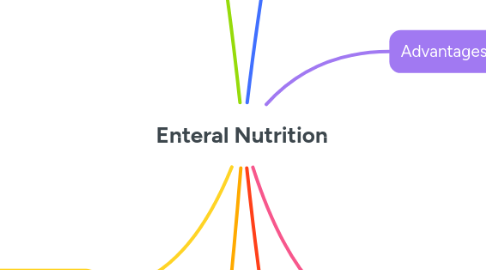
1. Indications
1.1. Mechanical disorders of swallowing:
1.1.1. Head and neck injuries/tumors
1.1.2. Radiotherapy/chemotherapy aftermath
1.1.3. Partial stenosis of the digestive tract
1.1.4. Digestive system surgery
1.2. Neuromotor disorders of swallowing:
1.2.1. Cerebrovascular accidents (CVA)
1.2.2. Brain tumors
1.2.3. Decreased consciousness
1.2.4. Degenerative diseases
1.3. Disturbances in digestion/absorption:
1.3.1. Malabsorption syndromes
1.3.2. Pancreatitis
1.3.3. Inflammatory bowel disease
1.3.4. Short bowel syndrome
1.4. Special nutrient needs:
1.4.1. Sepsis, burns, cancer
1.4.2. Renal insufficiency, cystic fibrosis
1.4.3. Multiple trauma, HIV
1.5. Denial of food consumption:
1.5.1. Hyperemesis gravidarum
2. Contraindications
2.1. Nonfunctioning GI tract:
2.1.1. Intestinal obstruction/perforation
2.1.2. Severe ileus
2.1.3. Incoercible vomiting
2.1.4. Acute digestive bleeding
2.2. Inability to absorb nutrients:
2.2.1. High-debit enteric fistulas
2.2.2. Severe diarrhea
2.3. Other contraindications:
2.3.1. Longterm feeding (>6 weeks)
2.3.2. Esophageal stricture/fistulas
2.3.3. Fractures/nosebleeds
3. Access Routes
3.1. Gastrostomy:
3.1.1. Surgical gastrostomy (Stamm, Witzell, Janeway)
3.1.2. Radiological percutaneous gastrostomy
3.1.3. Percutaneous endoscopic gastrostomy (PEG)
3.2. Nasoenteral tubes:
3.2.1. Nasogastric, nasoduodenal, nasojejunal
3.2.2. Transnasal route, distal end location based on clinical needs
3.3. Ostomy tubes:
3.3.1. Surgical, radiological, or endoscopic placement
3.3.2. Indicated for longterm feeding (>46 weeks)
3.4. Jejunostomy:
3.4.1. Tube in jejunal lumen, externalized through abdominal wall
3.4.2. Indicated for esophageal/stomach carcinoma, gastric trauma
3.4.3. Advantages: Reduced gastroesophageal reflux, less aspiration risk
4. Formulas
4.1. Types:
4.1.1. Nutritionally complete: Sole food source, covers all nutritional needs
4.1.2. Modules: Single nutrient preparations
4.1.3. Supplements: Complement oral diet, not balanced
4.2. Polymeric formulas:
4.2.1. Macromolecular nutrients
4.2.2. Normocaloric, hypercaloric, hyperprotein variants
4.2.3. Fiber options (soluble/insoluble)
4.3. Oligomeric formulas:
4.3.1. Hydrolyzed nutrients for dysfunctional GI tracts
4.3.2. Higher carbohydrate content, lower fat
4.3.3. Oligomeric peptides or elemental (L-amino acids)
5. Advantages
5.1. Physiological route:
5.1.1. Mimics natural digestion
5.2. Preserves gut function:
5.2.1. Maintains intestinal integrity
5.3. Cost-effective:
5.3.1. Less expensive than parenteral nutrition
5.4. Reduced infection risk:
5.4.1. Lower risk of sepsis compared to IV nutrition
5.5. Flexibility:
5.5.1. Can be used at home (Home Enteral Nutrition HEN)
6. Disadvantages
6.1. GI complications:
6.1.1. Diarrhea, vomiting, esophagitis
6.2. Mechanical issues:
6.2.1. Tube obstruction, dislodgment
6.3. Risk of aspiration:
6.3.1. Especially with nasogastric tubes
6.4. Metabolic imbalances:
6.4.1. Hypernatremia, potassium/glucose abnormalities
6.5. Patient discomfort:
6.5.1. Nasal/oral irritation, abdominal discomfort
7. Complications
7.1. Gastrointestinal:
7.1.1. Diarrhea (most common), emesis, inadequate gastric emptying
7.1.2. Gastrointestinal bleeding, esophagitis
7.2. Metabolic:
7.2.1. Hypernatremic dehydration (elderly patients)
7.2.2. Potassium/glucose imbalances, acid-base disturbances
7.3. Mechanical:
7.3.1. Aspiration (life threatening)
7.3.2. Tube obstruction, dislodgment
7.4. Infectious:
7.4.1. Risk of contamination (especially with culinary formulas)
